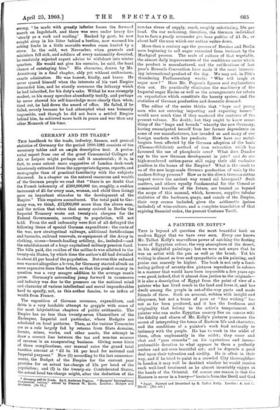GERMANY AND ITS TRADE.*
THIS handbook to the trade, industry, finance, and general statistics of Germany for the period 1890-1901 consists of the necessary tables and an ample descriptive text. A profes- sorial expert from one of the great Commercial Colleges of Aix or Leipsic might perhaps call it amateurish; it is, in fact, to some extent more suggestive of London desk-work laboriously extracted from the appropriate figures, reports, and monographs than of practical familiarity with the subjects discussed. In a chapter on the natural resources and wealth of the German people we read that " there is no doubt that the French indemnity of £200,000,000 (or, roughly, a sudden increment of £5 for every man, woman, and child then living) gave an important stimulus to the development of the Empire." This requires amendment. The total paid to Ger- many was, we think, £12,000,000 more than the above sum, and the notion that when that money arrived in Berlin the Imperial Treasury wrote out twenty-six cheques for the Federal Governments, according to population, will not hold. From the said indemnity were first of all defrayed the following items of special German expenditure : the costs of the war, new strategetical railways, additional fortifications and barracks, railroad renewals, re-equipment of the Army in clothing, stores—breech-loading artillery, &c., included—and the establishment of a huge capitalised military pension fund. The bills paid, the residue of the milliards was allotted to the twenty-six States, by which time the author's £5 had dwindled to about £1 per head of the population. But even this reduced sum was not altogether a, bonus, for Germany started afresh on more expensive lines than before, so that the pocket-money in question was a very meagre addition to the average man's purse. Germany's astounding jump forward in commerce and industry was due to the pressure on the national mind and character of various intellectual and moral imponderables hard to specify, not, as this author fancies, to an influx of wealth from France.
The exposition of German revenues, expenditure, and debts is a very laudable attempt to grapple with some of the most labyrinthine chapters of public arithmetic. The Empire has no less than twenty-seven Chancellors of the Exchequer, Imperial and particular, whose Budgets are scheduled on local patterns. Then, as the various Treasuries are as a rule largely fed by returns from State domains, forests, mines, works, and other assets, the attempt to draw a correct line between the tax and non-tax sources of revenue is an exasperating business. Giving some hints of these complications, our manual rates the grand total taxation amount at " 5s. ld. per head for national and Imperial purposes." Now (1) according to the last announce- ments, the Budget of the Empire for the current year provides for an actual tax-charge of 13s. per head of the population; and (2) in the twenty-six Confederated States, the actual local tax-charge might, after the deduction of the
• Germany and its Trade. By G. Ambrose Pogson. " Harpers' International Commercial Veries,“ edited by Francis W. Hirst,. London ; Harper and „ ."1.""eza. LS% Sd. non-tax rivers of supply, reach, roughly calculating, 10s. per head. On our reckoning, therefore, the German individual has to face a yearly surrender pro bono publieo of £1 3s., or about half the sum which our author writes down.
More than a century ago the grocers of Breslau and Berlin were beginning to sell sugar extracted from beetroot by the Markgraf process. The scale of culture of that vegetable, the almost daily improvements of the conditions under which the product is manufactured, and the ratifications of last year's Brussels Convention have made it the most interest- ing international product of the day. We may ask, in Pitt's thundering Parliamentary words : "Who will laugh at sugar now ? " Here Mr. Pogson's figures and explanations thin out. He practically eliminates the machinery of the Imperial sugar Excise as well as the arrangements for rebate on exportation which constitute the bounty system, and the statistics of German production and domestic demand.
The editor of the series thinks that " boys and young men who are entering importing and exporting houses" would save much time if they mastered the contents of the present volume. No doubt; but they ought to know some- thing of the "leaps and bounds" whereby the new Germany, having emancipated herself from her former dependence on some of our manufacturers, has invaded us and many of our foreign markets with her products. How have our metal- lurgists been affected by the German adoption of the basic (Thomas-Gilchrist) method of iron extraction which has favoured the use of phosphoric ores ? What does Dundee say to the new German development in jute ? and do our high-numbered cotton-yarns still enjoy their old exclusive position in the looms of the Empire ? What is the result to us of the new large-scale German production of soda by the modern Solvay process ? How as to the direct German cotton import versus the ancient way round viii Liverpool ? Such matters, and others equally fundamental for the Consul or commercial traveller of the future, are treated as beyond the scope of this manual, which, however, supplies tabular statistics of the harbours, quays, and canals of the Empire, their very cranes included, gives the arithmetic (prices included) of wine-culture, and a complete translation of that expiring financial codex, the present Customs Tariff.


























































 Previous page
Previous page